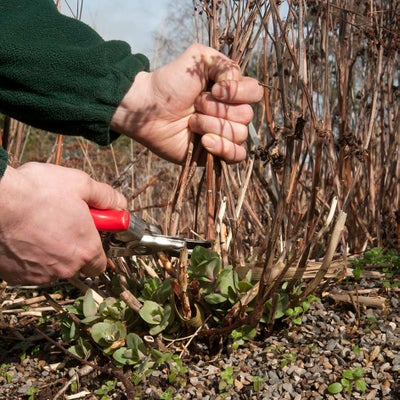
Quick facts
Suitable for - All but a few perennials and ornamental grasses
Timing - Autumn until spring
Difficulty - Easy
Suitable for...
All herbaceous and ornamental grasses that die back to soil level.
When to cut back perennials
Cutting back herbaceous during autumn restores order and tidiness to the garden. However, this removes potential winter interest, in the form of height and structure, plus food and habitat sources for wildlife so many gardeners delay the cut back until spring.
Selective cutting back in autumn can retain the dried, bleached flowerheads of plants, while removing material showing signs of decay or fungal growth. Examples include: such as Eryngium (sea holly), Phormium (New Zealand flax) and the foliage and flowers of ornamental grasses.
More tender plants with woody stems, such as penstemons, are left so that the old stems protect the crown from frost. Leave pruning of these and other borderline-hardy perennials until the risk of frost has passed – usually April or May.
Evergreen perennials such as certain Kniphofia and ornamental sedges are not cut back, but are tidied during spring and summer by removing dead foliage.
After cutting back, and fertilise to promote growth and flowering.
How to cut back perennials
Although the general principles are the same, there are a few differences depending on what season the work is carried out. This is explained below.
Cutting back in autumn and winter
- Using a knife, shears or secateurs, cut stems close to the ‘crown’ or base of the plant
- If there is any young growth, cut to just above it
- Take the opportunity to remove weeds, digging out those with thick or fleshy roots
- Cut back that produce leaves and flower stems from below the soil level, such as Crocosmia and paeony, to soil level
- Less severely cut back perennials showing new basal shoot growth – asters and Sedum spectabile, for example
- Any attractive dead stems or flower heads can be left until early spring
- Separate and burn any diseased material (showing signs of leaf-spots, mildew and rusts, for example). Add all other material, excepting ripening seed heads, to the heap
- Apply a light and feed in early spring
Cutting back in spring
Many gardeners choose to leave dead herbaceous plants and grasses over winter to provide structure to the garden, as well as food and shelter for wildlife. However, more care is needed when cutting back in spring to avoid damaging new shoot growth. Most gardeners start cutting back from March onwards:
- Using a knife, shears or secateurs cut stems close to the ‘crown’ or dormant top of the plant, avoiding the removal of new shoots
- In spring, new growth arises from the base of herbaceous plants (including grasses) that die back to ground level over winter. This is best not removed during cutting back
- Evergreen perennials, or those such as penstemons, that should survive the winter in milder areas, may either shoot from the base or from branching points higher up the old shoots. Where growth arises purely from the base, cut the old stems back entirely to within a few centimetres of the ground, leaving the new shoots open to light and air. Where growth arises higher up, simply shorten the old stems, cutting to just above a healthy leaf, branch or
- Tidy up the base of the plant, removing debris and replacing mulch as necessary
Cutting back after flowering
Early-flowering perennials such as geraniums and delphiniums are cut to near ground level after flowering to encourage fresh foliage and late summer flowering. These are then cut back again in autumn or spring.
Problems
Sometimes gardeners are caught out by earlier-than-expected growth of in spring. In these cases, rather than cutting out new growth, merely tidy up the plants by pulling out dead stems.
In very wet winters, the soil can be too wet to access plants without compacting soggy soil. Rather than damaging the soil, it is best to wait until it is drier in spring; and then tidy up the plants by pulling out dead stems. Where soils are prone to waterlogging and damage, carry out cutting back in autumn.








